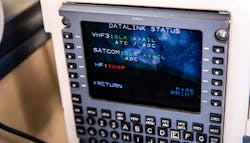Inmarsat, ESA perform first flight test under Iris air traffic management program
LONDON -- Satellite communications provider Inmarsat and the European Space Agency have completed the first test flight for their Iris program, which aims to modernize European air traffic through more precise flight surveillance and efficient air traffic management.
Iris, a public-private partnership led by Inmarsat and sponsored by the ESA, supports the Single European Sky ATM Research (SESAR) plan's objectives of enhancing airspace utilization, safety, CO2 emissions, and reducing flight times and delays.
This would be accomplished by tracking aircraft more accurately in four dimensions -- latitude, longitude, altitude and time -- allowing pilots and controllers to save fuel by calculating better routes, cruising at optimum altitudes, using continuous climb and descent paths.
Iris was tested during a three-hour test at Amsterdam's Schiphol Airport, using a Cessna Citation II provided by Dutch company NLR and equipment from partners Honeywell, CGI and SITAONAIR.
"Our previous test flights were conducted during the Iris development phase, using a combination of simulated systems and existing terminals," said John Broughton, Vice President of Aviation Safety and Operational Services at Inmarsat. "The fact that we have now flown with the programs' actual avionics systems shows the excellent progress being made.
"All performance objectives were met and now the Iris consortium moves on to the next major milestone: the objective of making Iris an operational system in 2020."
After large-scale validations to be carried out by unnamed airlines in 2020, the group will move to launch a fully-operational service in 2021. Both represent key milestones for Iris to then be integrated into the European Commission's Datalink Strategy, according to Inmarsat.
"It's important for Europe to address the issue of rising airline passenger volumes and limited airspace capacity," said Magali Vaissier, Director of Telecommunications and Integrated Applications at ESA. "The fact that the Iris program has been designed to enable more efficient, cost-effective air traffic management will be welcomed by the aviation industry, as well as airline passengers and Europe as a whole."
IP-based satellite communications programs like Iris could translate to savings of US$3 billion annually, per a report issued last month by the London School of Economics.
